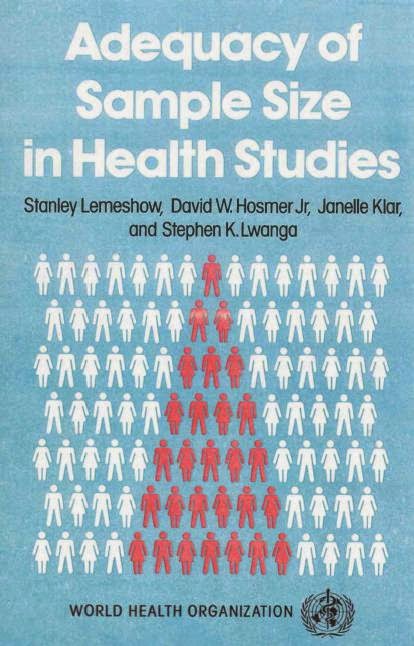Title: Sample
size determination in health studies : a practical manual / S. K. Lwanga and S.
Lemeshow
Authors: Lwanga,
Stephen Kaggwa
Issue Date: 1991 Publisher: Geneva
: World Health Organization
Language: English
Abstract:
Presents the
practical and statistical information needed to help investigators decide how
large a sample to select from a population targeted for a health study or
survey. Desgned to perform a cookbook function, the book uses explanatory text
and abundant tabular calculations to vastly simplify the task of determining
the minimum sample size needed to obtain statistically valid results. The
objective is to assist those investigators, undertaking health studies at local
or district level, who lack detailed knowledge of statistical methodology.
Acknowledging that the size of a sample will depend on the aims, nature, and
scope of the study, the first part of the book provides a practical framework
for working through the steps of sample size determination once a proposed
study and its objectives have been clearly defined. In six chapters, readers
are introduced to a variety of situations in which minimum sample size must be
determined, including studies of population proportion, odds ratio, relative
risk, and disease incidence. Each situation is first defined in terms of the
information required and then illustrated by a hypothetical example of a study
objective and the questions that will need to be answered in order to determine
the appropriate sample size. The solution to each problem is clearly stated,
together with relevant explanatory notes. The second part of the book features
more than 50 pages of tables that enable the reader to determine the sample
size required, under simple random sampling, in a given type of study without
recourse to complicated calculations. Each of the illustrative examples
featured in the first part of the book includes a reference to one of these
tables, thus showing investigators how to move from the objectives and design
of a study to the rapid calculation of an appropriate sample size. Examples and
tables were selected as representing many of the approaches most likely to be
adopted in health studies Description: 80 p.
Other Identifiers: 9241544058Appears in Collections:Publications – See more at: http://apps.who.int/iris/handle/10665/40062#sthash.qvDzU8Tx.dpuf



